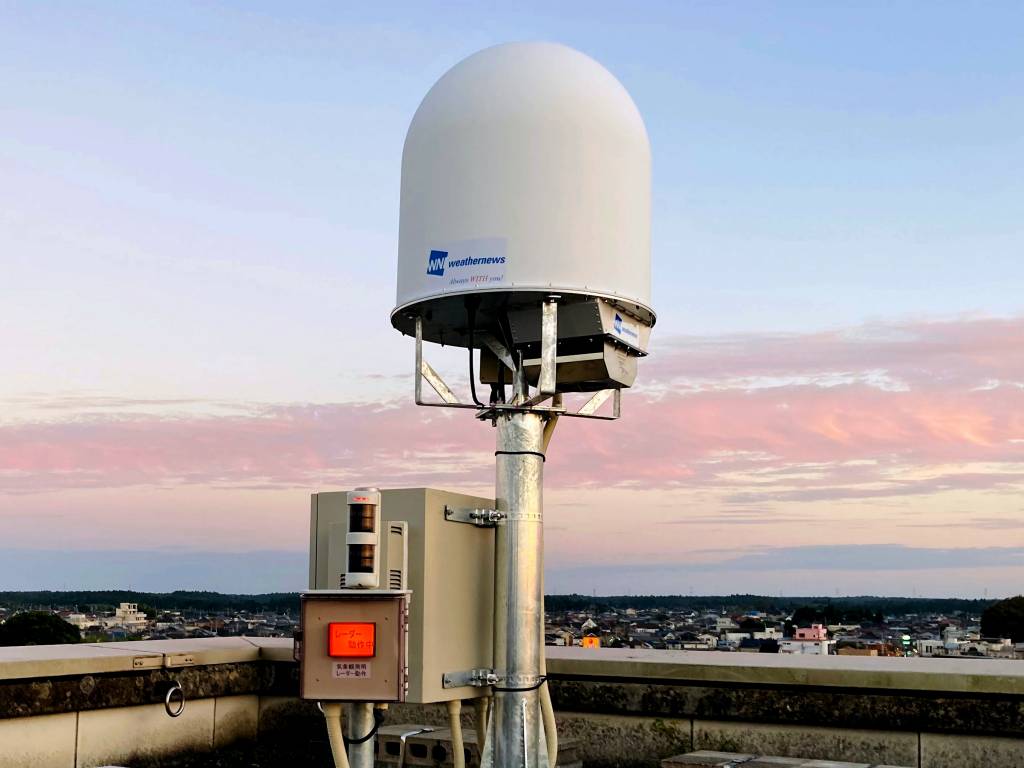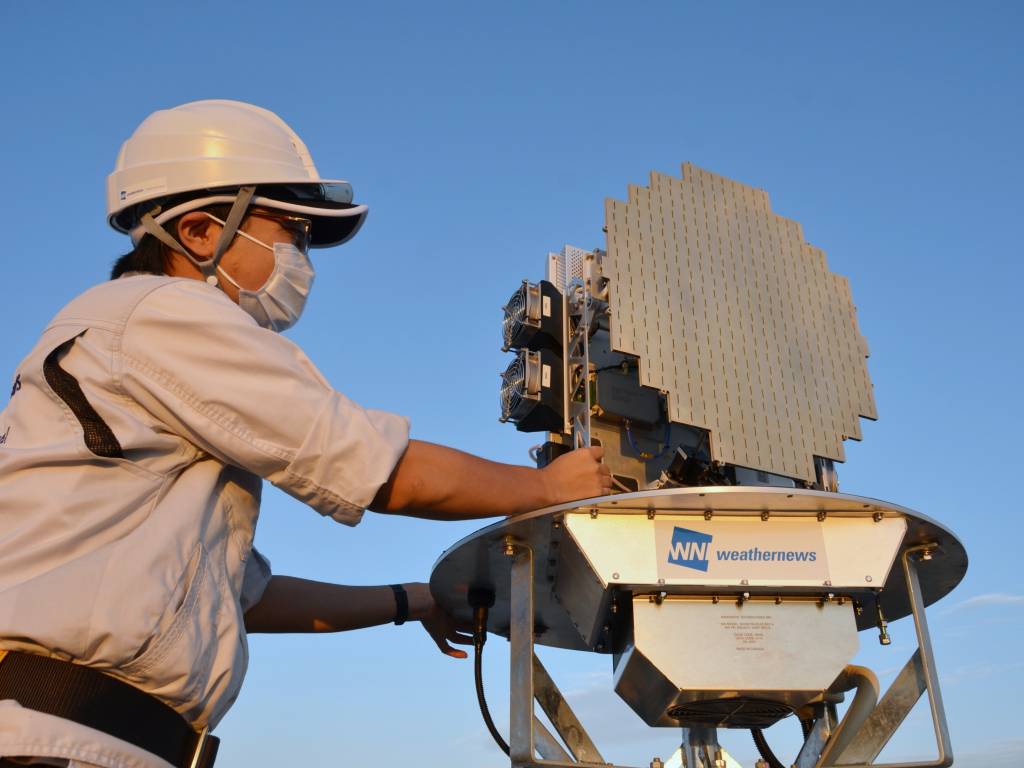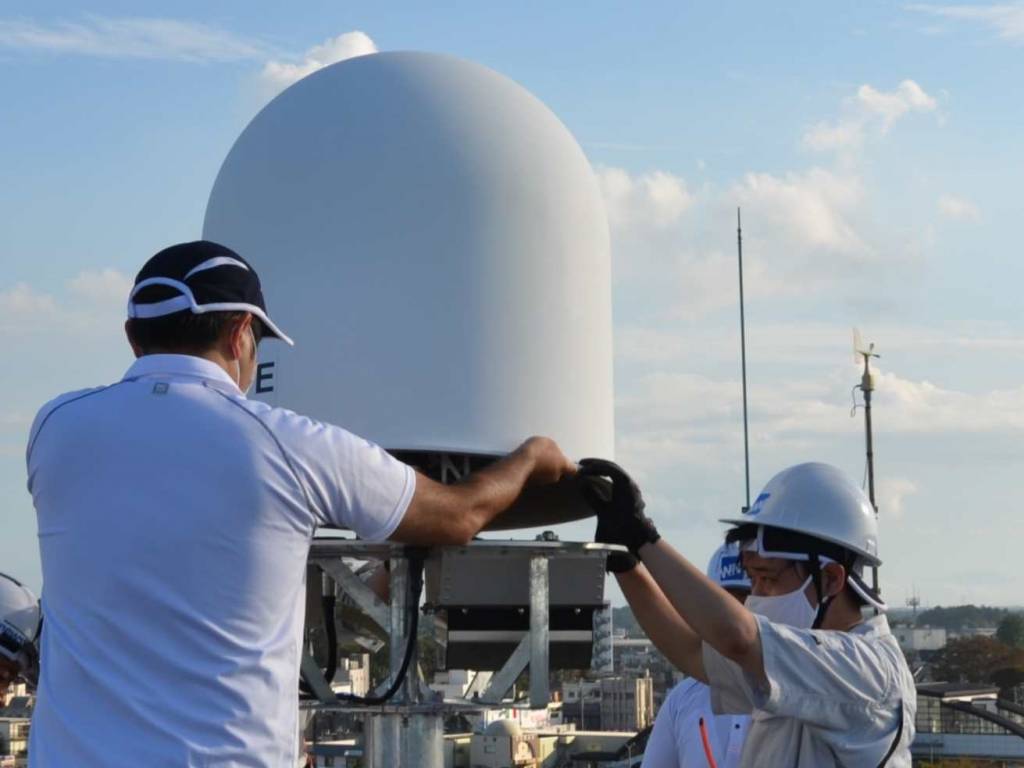News & Press Release
Field Test Initiated of New Radar for 3D Observation of 50-km Periphery in 30 Seconds to Reinforce Monitoring of Weather Events in Japan and Asia;
High-Speed 360-Degree Scans of Rain Clouds to Enhance Forecast Accuracy of "Guerilla Rainstorms" and Linear Precipitation Zones. Installation Planned in 50 Locations within Two Years.
Road Management >Weathernews Inc. has installed the high-frequency compact EAGLE weather radar in Chiba Prefecture and initiated a field test to verify its efficacy. We will be evaluating the accuracy of the radar and making final adjustments until June 2022.
Weathernews' proprietary EAGLE radar is a compact meteorological radar that performs high-speed 360-degree scans of its periphery and observes the spatial structures of clouds at a high frequency. The radar is characterized by its ability to perform three-dimensional observations in 30 seconds, unlike the current WITH radars that require five minutes. The radar enables near real-time tracking of the development of cumulonimbus clouds within a 50 km radius, making it possible to capture guerilla thunderstorms, linear precipitation zones, heavy snow, wind gusts, hail, and other sudden, localized weather events with greater accuracy.
The Weathernews Forecast Center will monitor the radar and utilize the observation data to improve forecast accuracy. We will also develop new services, such as support for road management companies in making snow removal decisions. Further, we are planning to install the radar in a total of 50 locations in Asia within two years to reinforce the global weather monitoring system.
Installing an EAGLE radar and checking the operation
Weathernews Develops New High-Frequency Compact Meteorological Radar EAGLE
Weathernews developed the compact WITH weather radar in 2009, which we installed and are operating in 80 locations throughout Japan. We have been able to confirm the efficacy of compact meteorological radars, having tested them for more than ten years through the observation of events such as guerilla thunderstorms and wind gusts. However, because the existing WITH radars require about five minutes for omnidirectional 3D observation, the detailed tracking of the rapidly developing and changing clouds had been difficult.
To enable higher frequency observations, Weathernews developed the new high-frequency compact meteorological radar EAGLE as a successor to the WITH Radar. This WNI-proprietary radar , through 360-degrees high-speed scanning, enables near real-time spatial observation of the size of rain drops and the direction in which the clouds are moving. The radar completes a rotation in a minimum of five seconds , quickly obtaining detailed three-dimensional data over a 50 km radius in 30 seconds. The achievement of high-speed observation will render it possible to capture guerilla thunderstorms, linear precipitation zones, heavy snow, wind gusts, hail, and other sudden, localized weather events.
Installing an EAGLE radar in Yachimata City, Chiba Prefecture, for a field test
Initiated Field Test of EAGLE Radar Installed in Chiba Prefecture
Weathernews has installed an EAGLE radar in Chiba Prefecture and initiated a field test. We will be evaluating the accuracy of the radar and making final adjustments until June 2022. As regards the utilization of the radar, the Weathernews Forecast Center will begin by monitoring the radar and using the observation data to improve the accuracy of forecasts for periods of a few hours ahead. As was the case with the WITH radars, we will not only be capturing the state of clouds in 3D but will also be working on the development of services concurrently with the field test. We will initially focus on Japanese companies, developing services such as decision-making support relating to snow removal and detour recommendations for road management companies.
WNI Plans to Install 50 Radars by 2023 to Reinforce Weather Monitoring in Asia
Weathernews has been working on the development of the EAGLE radar in collaboration with the University of Oklahoma since 2014. Further, we signed a memorandum of understanding with Nanowave in June 2017 regarding the mass production of radars. Although we fell behind our initial plan due to changes in the specifications and production lines for the meteorological radars, as well as the effect of the global semiconductor shortage, we will be installing the radars in a total of 50 locations throughout Asia within the next two years under the current plan.
Weathernews will continue to install radars and strengthen the weather monitoring system in Asian regions, where there is insufficient observation data.

ABOUT NANOWAVE:
The Canadian radio frequency electronics firm established a research group near the Radar Innovations Laboratory on the OU Research Campus to continue its collaboration on the development of next-generation electromagnetic sensors. Nanowave, a Toronto-based company, builds extremely high-reliability radio frequency subsystems for a large percentage of the airborne weather radar and satellite communications markets. Nanowave is one of eight weather-related companies to locate on the OU Research Campus. Learn more about Nanowave at www.nanowavetech.com.

